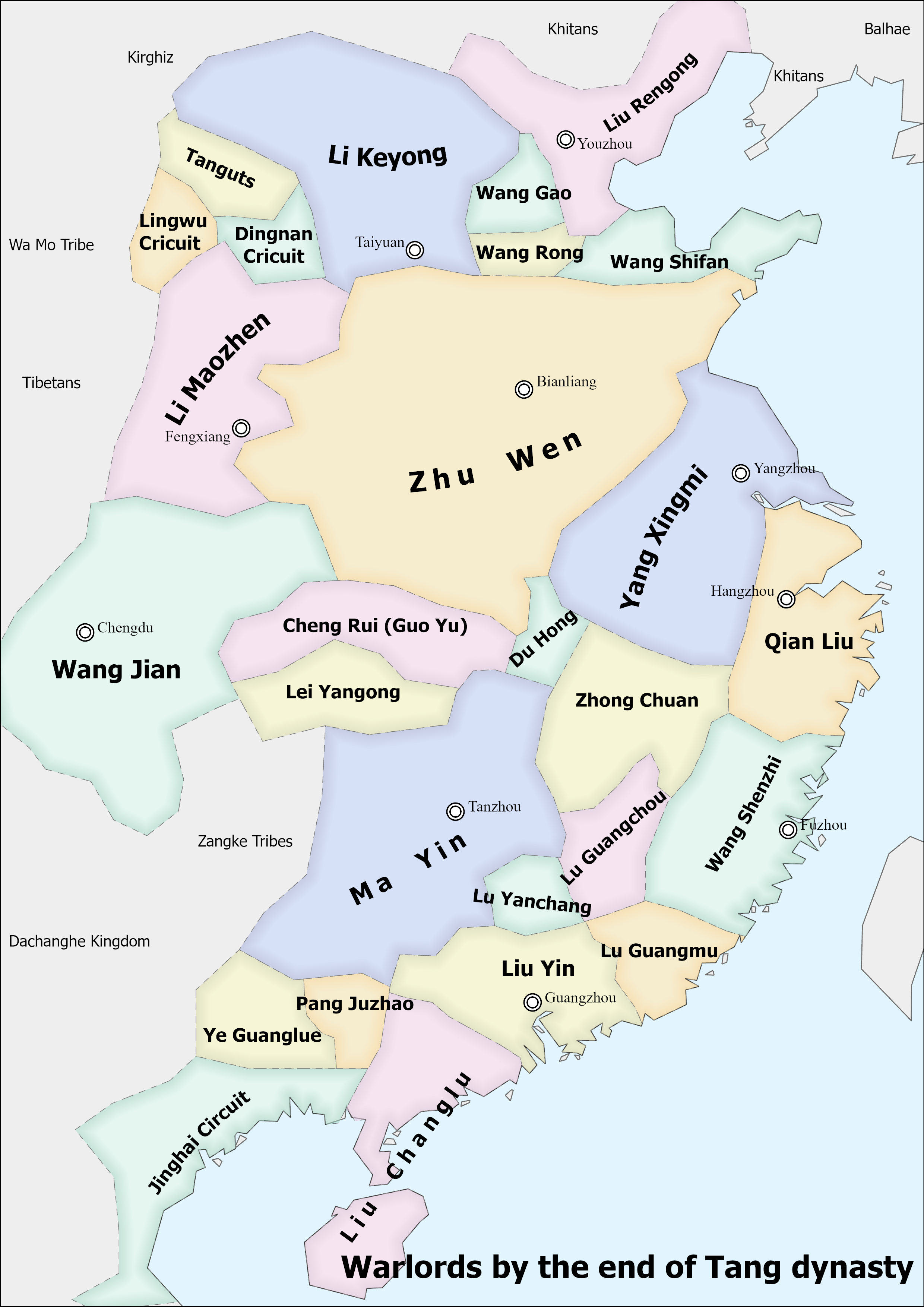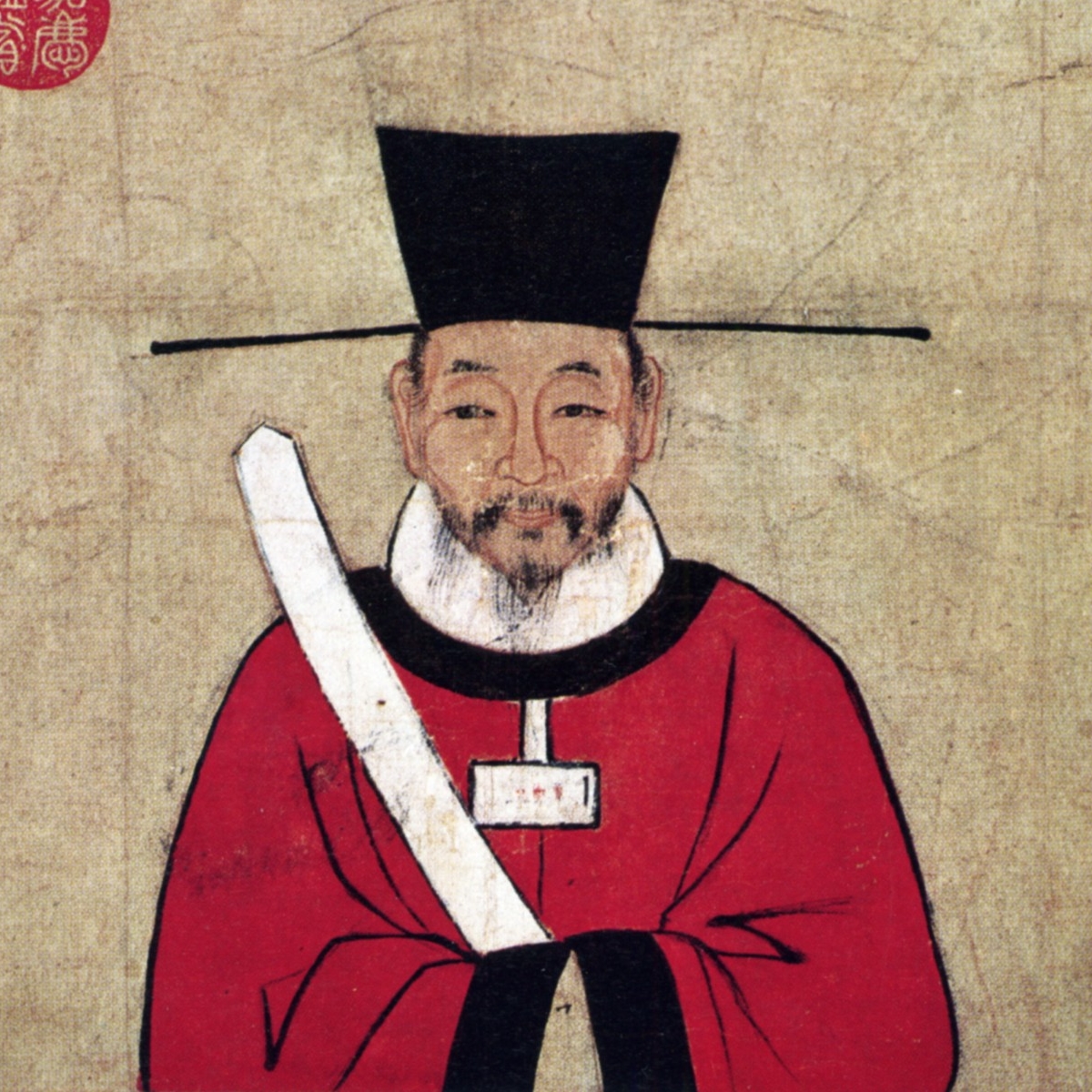|
Li Quanzhong
Li Quanzhong () (d. 886) was a warlord late in the Chinese Tang dynasty, who controlled Lulong Circuit (盧龍, headquartered in modern Beijing) from 885, when he overthrew the prior military governor (''jiedushi'') Li Keju, to his death in 886. His sons Li Kuangwei and Li Kuangchou successively served as military governors after he died. Background It is not known when Li Quanzhong was born, but it is known that he was from Lulong Circuit's capital Fanyang (). During Emperor Xizong's ''Guangming'' era (880–881), he served as the military advisor to the prefect of Di Prefecture (棣州, in modern Binzhou, Shandong). After that term, he returned to Lulong and served under the military governor Li Keju.''Old Book of Tang'', vol. 180. Seizure of Lulong In spring 885, Li Keju and his ally Wang Rong the military governor of Chengde Circuit (成德, headquartered in modern Shijiazhuang, Hebei), were apprehensive that Wang Chucun the military governor of Yiwu Circuit (義 ... [...More Info...] [...Related Items...] OR: [Wikipedia] [Google] [Baidu] |
History Of China
The history of China spans several millennia across a wide geographical area. Each region now considered part of the Chinese world has experienced periods of unity, fracture, prosperity, and strife. Chinese civilization first emerged in the Yellow River valley, which along with the Yangtze basin constitutes the geographic core of the Chinese cultural sphere. China maintains a rich diversity of ethnic and linguistic people groups. The traditional lens for viewing Chinese history is the dynastic cycle: imperial dynasties rise and fall, and are ascribed certain achievements. This lens also tends to assume Chinese civilization can be traced as an unbroken thread many thousands of years into the past, making it one of the cradles of civilization. At various times, states representative of a dominant Chinese culture have directly controlled areas stretching as far west as the Tian Shan, the Tarim Basin, and the Himalayas, as far north as the Sayan Mountains, and as far south ... [...More Info...] [...Related Items...] OR: [Wikipedia] [Google] [Baidu] |
Wang Chucun
Wang Chucun () (831–895) was a general of the Chinese Tang dynasty, who controlled Yiwu Circuit (義武, headquartered in modern Baoding, Hebei) in late Tang. He was one of the main contributors in Tang's eventual defeat of the agrarian rebel Huang Chao. Background Wang Chucun was born in 831, during the reign of Emperor Wenzong. His family was from the Tang dynasty capital Chang'an, and his ancestors had served as officers in the imperial Shence Armies for generations. His father Wang Zong () was not only a highly ranked general in the Shence armies but was also a skillful merchant. It was said that Wang Zong became so rich that he was able to be extravagant in his food and to have thousands of servants. Wang Chucun himself started his career as the commander at a Shence Army base, and he later became a general and a patrol commander.''Old Book of Tang'', vol. 182. Yet later, he was made the overseer (制置使, ''Zizhishi'') of the army at Ding Prefecture (定州, in mod ... [...More Info...] [...Related Items...] OR: [Wikipedia] [Google] [Baidu] |
886 Deaths
__NOTOC__ Year 886 ( DCCCLXXXVI) was a common year starting on Saturday of the Julian calendar. Events By place Byzantine Empire * March – A wide-ranging conspiracy against Emperor Basil I, led by John Kourkouas, is uncovered. * August 29 – Emperor Basil I the Macedonian dies from a fever, contracted after a hunting accident. He is succeeded by the 19-year-old Leo VI, a son of former emperor Michael III, as sole ruler (''basileus'') of the Byzantine Empire. After his coronation Leo reburies the remains of his father with great ceremony in the imperial mausoleum, within the Church of the Holy Apostles in Constantinople. Europe * October – Siege of Paris: Count Odo slips through Viking-controlled territory, to ask the king of West Francia Charles the Fat for support. He returns with a relief force, and reaches safety within the walls. Charles arrives later with a large army, and establishes a camp at Montmartre. After negotiations he promises the Vik ... [...More Info...] [...Related Items...] OR: [Wikipedia] [Google] [Baidu] |
9th-century Births
The 9th century was a period from 801 (represented by the Roman numerals DCCCI) through 900 (CM) in accordance with the Julian calendar. The Carolingian Renaissance and the Viking raids occurred within this period. In the Middle East, the House of Wisdom was founded in Abbasid Baghdad, attracting many scholars to the city. The field of algebra was founded by the Muslim polymath al-Khwarizmi. The most famous Islamic scholar Ahmad ibn Hanbal was tortured and Imprisonment, imprisoned by Abbasid official Ahmad ibn Abi Du'ad during the reign of Abbasid caliph al-Mu'tasim and caliph al-Wathiq. In Southeast Asia, the height of the Mataram Kingdom happened in this century, while Burma would see the establishment of the major kingdom of Pagan Kingdom, Pagan. Tang china, Tang China started the century with the effective rule under Emperor Xianzong of Tang, Emperor Xianzong and ended the century with the Huang Chao#Rebellions, Huang Chao rebellions. In America, the Maya civilization, Ma ... [...More Info...] [...Related Items...] OR: [Wikipedia] [Google] [Baidu] |
New Book Of Tang
The ''New Book of Tang'', generally translated as the "New History of the Tang" or "New Tang History", is a work of official history covering the Tang dynasty in ten volumes and 225 chapters. The work was compiled by a team of scholars of the Song dynasty, led by Ouyang Xiu and Song Qi. It was originally simply called the ''Tangshu'' (唐書, Book of Tang) until the 18th century. History In Chinese history, it was customary for dynasties to compile histories of their immediate predecessor as a means of cementing their own legitimacy. As a result, during the Later Jin (Five Dynasties), Later Jin dynasty of the Five Dynasties and Ten Kingdoms period, a history of the preceding Tang dynasty, the ''Old Book of Tang'' () had already been compiled. In 1044, however, Emperor Renzong of Song ordered a new compilation of Tang history, based on his belief that the original ''Old Book of Tang'' lacked organization and clarity. The process took 17 years, being finally completed in 1060. ... [...More Info...] [...Related Items...] OR: [Wikipedia] [Google] [Baidu] |
Liu Rengong
Liu Rengong () (died 914) was a warlord late in the Chinese Tang dynasty who controlled Lulong Circuit (盧龍, headquartered in modern Beijing) from 895 (when his one-time lord Li Keyong conquered Lulong and left him in charge of it) to 907 (when he was overthrown by his son Liu Shouguang and put under house arrest). He was initially a Lulong officer, but later fled to Li Keyong's Hedong Circuit (河東, headquartered in modern Taiyuan, Shanxi). After Li conquered Lulong and left him in charge, he turned against Li and became an independent warlord, although at times he and Li would still act in concert. His domain later became the basis of the Five Dynasties and Ten Kingdoms period state Yan that Liu Shouguang established. In 913, however, Li Keyong's son and successor Li Cunxu the Prince of Jin conquered Yan and captured both Liu Shouguang and Liu Rengong; he put them to death the next year. Background It is not known when Liu Rengong was born—although he was said to b ... [...More Info...] [...Related Items...] OR: [Wikipedia] [Google] [Baidu] |
Zizhi Tongjian
The ''Zizhi Tongjian'' (1084) is a chronicle published during the Northern Song dynasty (960–1127) that provides a record of Chinese history from 403 BC to 959 AD, covering 16 dynasties and spanning almost 1400 years. The main text is arranged into 294 scrolls (), each equivalent to a chapter—totaling around 3 million Chinese characters. In 1065, Emperor Yingzong of Song commissioned his official, Sima Guang (1019–1086), to lead a project to compile a Universal history (genre), universal history of China, and granted him funding and the authority to appoint his own staff. His team took 19 years to complete the work and in 1084 it was presented to Emperor Yingzong's successor Emperor Shenzong of Song. It was well-received and has proved to be immensely influential among both scholars and the general public. Endymion Wilkinson regards it as reference quality: "It had an enormous influence on later Chinese historical writing, either directly or through its many a ... [...More Info...] [...Related Items...] OR: [Wikipedia] [Google] [Baidu] |
Shanxi
Shanxi; Chinese postal romanization, formerly romanised as Shansi is a Provinces of China, province in North China. Its capital and largest city of the province is Taiyuan, while its next most populated prefecture-level cities are Changzhi and Datong. Its one-character abbreviation is (), after the Jin (Chinese state), state of Jin that existed there during the Spring and Autumn period (). The name ''Shanxi'' means 'west of the mountains', a reference to its location west of the Taihang Mountains. Shanxi borders Hebei to the east, Henan to the south, Shaanxi to the west and Inner Mongolia to the north. Shanxi's terrain is characterised by a plateau bounded partly by mountain ranges. Shanxi's culture is largely dominated by the ethnic Han Chinese, Han majority, who make up over 99% of its population. Jin Chinese is considered by some linguists to be a distinct language from Mandarin and its geographical range covers most of Shanxi. Both Jin and Mandarin are spoken in Shanxi. ... [...More Info...] [...Related Items...] OR: [Wikipedia] [Google] [Baidu] |
Taiyuan
Taiyuan; Mandarin pronunciation: (Jin Chinese, Taiyuan Jin: /tʰai˦˥ ye˩˩/) is the capital of Shanxi, China. Taiyuan is the political, economic, cultural and international exchange center of Shanxi Province. It is an industrial base focusing on energy and heavy chemicals. Throughout its long history, Taiyuan was the capital or provisional capital of many dynasties in China, hence the name ( zh, s=龙城, p=Dragon City, labels=no). As of 2021, the city governs 6 districts, 3 counties, and hosts a county-level city with a total area of 6,988 square kilometers and a permanent population of 5,390,957. Taiyuan is located roughly in the centre of Shanxi, with the Fen River flowing through the central city. Etymology and names The two Chinese characters of the city's name are (, "great") and (, "plain"), referring to the location where the Fen River leaves the mountains and enters a relatively flat plain. Throughout its long history, the city had various names, including ... [...More Info...] [...Related Items...] OR: [Wikipedia] [Google] [Baidu] |
Li Keyong
Li Keyong ( zh , c = 李克用 , p = Lǐ Kèyòng ) (October 24, 856 – February 24, 908) was a Chinese military general and politician of Shatuo ethnicity, and from January 896 the Prince of Jin ( zh, t=晉王, p=Jìn Wáng), which would become an independent state after the fall of the Tang dynasty in 907. Li served as a ''Jiedushi'' provincial military governor during the late Tang period and was an instrumental figure in the development of a Shatuo base of power in what is today's Shanxi Province of China. His son Li Cunxu (Emperor Zhuangzong), a child of his concubine Lady Cao, would succeed him as Prince of Jin and eventually become the founding emperor of the Later Tang dynasty in 923. Background Li Keyong—although he would have initially carried the surname of Zhuye—was born in 856, during the reign of Emperor Xuānzong. His father was the Shatuo chieftain Zhuye Chixin, whose people were then living in the Shenwu River (神武川, flowing through modern Shu ... [...More Info...] [...Related Items...] OR: [Wikipedia] [Google] [Baidu] |







